Abstract
Water plays a crucial role in the pharmaceutical industry, influencing both product quality and manufacturing process.. The effects of low-quality water in the pharmaceutical industry are far-reaching, impacting product quality, and operational efficiency. To mitigate these risks, pharmaceutical companies must implement robust water quality monitoring and purification systems to ensure that the water used in manufacturing meets the required standards and specifications. There are different techniques used for purification of water in pharmaceutical industry and also using different parameters for detection of water contaminants. This review explores [1] Internet of Things (IoT) use technology in the pharmaceutical industry to maintain the quality in water. Utilizing a network of sensors, the system continuously collects [2] current information on a range of water characteristics crucial for pharmaceutical manufacturing processes. The data is then transmitted and analysed in a centralized system, enabling prompt detection of deviations from quality standards. This lOT -based approach enhances the efficiency of water quality management, ensuring compliance with regulatory requirements and contributing to the overall integrity of pharmaceutical production processes. The techniques which are used from last few years are time taking and cost effective. Nowadays [3] IoT (internet of things) device is Used[3] to monitor the quality of water in pharmaceutical industries. These IOT device consists [3] Temperature and PH , humidity and total dissolved solids (TDS) in water. This research work explains the use of IOT Tools like TDS, Conductivity, pH and turbidity sensors are used to monitor water quality in SPMVV
Keywords
Internet of things (IOT), Pharmaceutical industry, Water,[4] Humidity, TDS (total dissolved solids), and pH.
Introduction
One of the most important and abundant compounds of the ecosystem is water. For their growth and survival all living organisms need water on the earth. The planet I.e. earth only having 70% water. Water pollution is a pressing issue in India, affecting rivers, lakes, and groundwater. Factors include industrial discharge, untreated sewage, agricultural runoff, and improper waste disposal. Major rivers like the Ganges, Yamuna, and others face severe pollution, impacting human health and aquatic life. Humans suffer with water borne diseases due to usage of contaminated water .[5] Assessing the water's quality is necessary. Diseases from contaminated water are a public health concern. Government initiatives aim to improve water quality through stricter regulations, wastewater treatment, and awareness campaigns. Effective pollution control measures are essential for ensuring clean and safe water resources. Water pollution is a concern in Tirupati, a city in Andhra Pradesh, India, like in many other urban areas. The sources and issues of water pollution in Tirupati include, UnK Swathitreated Sewage The inadequate sewage treatment infrastructure in some parts of the city leads to the discharge of untreated sewage into water bodies. This sewage contains harmful bacteria, pathogens, and contaminants that can affect water quality and pose health risks. Agricultural Runoff: The use of fertilizers, pesticides, and chemicals in nearby agricultural areas can result in runoff that carries pollutants into water bodies. This can lead to nutrient pollution, algal blooms, and degradation of aquatic ecosystems. Industrial Activities. Certain industrial operations may release effluents containing pollutants into water sources. These pollutants can include heavy metals, chemicals, and other harmful substances that adversely impact water quality. Solid Waste Disposal: Improper disposal of solid waste and plastic can lead to litter entering water bodies, contributing to visual pollution and potential contamination. Urbanization and Development: Urban expansion can lead to increased impervious surfaces, reducing natural water infiltration and increasing the runoff of pollutants into water bodies. Religious Practices: Tirupati is a major pilgrimage destination, and during festivals and religious events, there can be instances of offerings being disposed of in water bodies, which may contribute to pollution. These are the major reasons affecting the water quality. In assessing the[6] safety and quality of water sources, water monitoring is crucial. Protecting both the environment and people is crucial. Because of increasing levels of pollution and demand for water. [7]Water pollution in particular has grown to be one of the biggest problems facing nations worldwide in recent years. Chemicals and water from the pandemic had been released into the river, sea, and pond because to the growth in factories and automobiles. In addition, when the chemical combines with the atmospheric water, the contaminated air that is released into the environment also results in acid rainnd have a shorter lifespan. Furthermore, using an excessive amount of fertiliser in agriculture will result in an excess of nutrients like phosphate and nitrogen. The toxic algal blooms brought on by the surplus nutrients will lower the dissolved oxygen in the water and pose a threat to Connecting software, hardware, and other physical things to[8] the Internet is known to as the Internet of Things, or simply IoT. More broadly, it is a dynamic, global network structure which employs actuators, electronics, sensors, software, and connectivity with intelligent objects and entities to enhance connection, collection, and data exchanges. This kind of network often contains a large number of nodes that exchange data and interact with the environment, all the while responding to events and initiating actions [9]In 1999, Kevin Ashton proposed the concept of an Internet of Things (IoT), describing it as a network of uniquely identified, connected items that utilise radio-frequency identification (RFID) technology. Nevertheless, the precise definition of the Internet of Things is still being developed and is dependent on several viewpoints. "Dynamic global network infrastructure with self-configuring capabilities based on standards and communication protocols" was the general definition of the Internet of things. In an IoT,[9] both virtual and physical objects have unique characteristics and identities. They can be integrated into an information network and use intelligent interfaces. IoT can be summed up as a collection of uniquely identified connected devices. The terms "Internet" and "Things" refer to a global network of interconnected devices and information that is powered by networking, information processing, and sensor technologies.
MATERIALS AND METHODS:
INTERNET OF THINGS SENSORS
REQUIRED TDS (TOTAL DISSOLVED SOLIDS) COMPONENTS:
- Arduino UNO Gravity Analog TDS Sensor
- Wire jumpers bread board
- LCD Screen
TDS Analog Gravity Sensor:
(10) The Gravity Analog TDS Sensor is a TDS sensor/Meter Kit that may be used with an Arduino to measure the TDS content in water. It can be used for hydroponics, household water, and other water quality testing applications. This product is compatible with 5V or 3.3V control systems or boards since it offers 3.3 ~ 5.5V broad voltage input and 0 ~ 2.3V analogue voltage output. Analog TDS Sensor for Gravity An AC signal serves as the excitation source and has the ability to successfully keep the probe from polarizing.
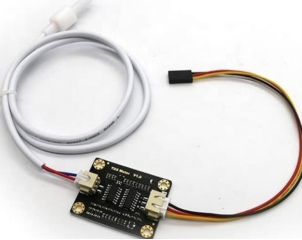
Fig no 1 TDS Analog Gravity Sensor
An AC signal serves as the excitation source, successfully preventing polarization of the probe and extending its lifespan.
ARDUINO:
(11) The Arduino microcontroller is a popular single-board computer for hobbyists and professionals due to its ease of use and tremendous capabilities. Since the Arduino is open-source, development software is free and hardware is cheaply priced. Students in ME 2011 or any other course who is dealing with an Arduino for the first time should refer to this handbook. Advanced Arduino users should search the web for many resources. The Arduino board appears like this.

Fig no 2 Arduino UNO
(12) Simplified C/C++ is the programming language used by Arduino. Programming the Arduino will be familiar to you if you know C. It's okay if you don't know C; all you need to know to do practical tasks is a few commands.
ARDUINO HARDWARE
The Arduino's power lies not in its computational prowess but in its ability to interface with the external world via its input-output (I/O) pins. The 14 digital I/O pins of the Arduino, numbered 0 through 13, can be used to read switch states and turn on and off lights and motors. About 40 mA of current can be either sourced or sunk by each digital pin. This means that interface circuits are required to control devices other than basic LEDs, but it is still more than sufficient for interacting with the majority of gadgets. To put it another way, an Arduino pin cannot be used to directly power a motor; instead, it must drive an interface circuit, which in turn.
3. Liquid Crystal Display, or LCD
(13) An electrical display module with many uses is the LCD (Liquid Crystal Display) screen. A 16x2 LCD display is a relatively basic module that is frequently seen in many different kinds of circuits and devices. Compared to other multi-segment LCDs particularly those with seven segments, these modules are preferable. The reasons are as follows: LCDs can display special and even custom characters (unlike in seven segments); they are inexpensive; they are easily programmable; and they can display animations and other content. An LCD that is 16 by 2 may show up to 16 characters on each of its two lines. Every character on this LCD is shown as a 5x7 pixel matrix. There are two registers on this LCD: Command and Data. The command instructions sent to the LCD are kept in the command register.
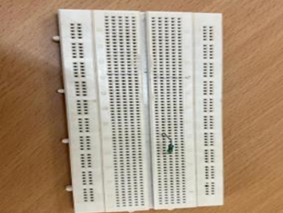
Fig no 3 Pin diagram of LCD display
4. BREAD BOARD:
A breadboard, also known as a protoboard or solderless breadboard, is a common tool used in electronics for building and testing electronic circuits. It is a rectangular board with a grid of holes, typically made of plastic, with metal clips or spring connectors beneath the holes. These connectors allow you to easily connect electronic components and wires without the need for soldering.
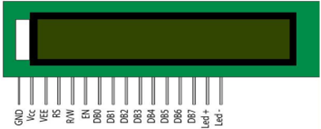
Fig no 4 Diagram of Bread board
JUMPER WIRES:
Jumper wires are electrical wires with connectors on either end that are used to create electrical connections between various components in electronic circuits or projects. They are a fundamental tool in electronics and prototyping, allowing you to easily connect different components on a breadboard, PCB (printed circuit board), or other electronic platforms
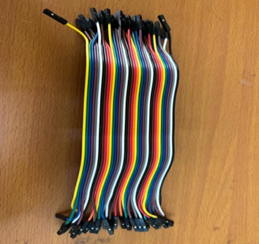
Fig no 5 Jumper wires
(10) Getting in the way of gravity Arduino-controlled analog TDS sensor with an LCD display to connect the Arduino and LCD display to the TDS sensor. Below is the circuit diagram.
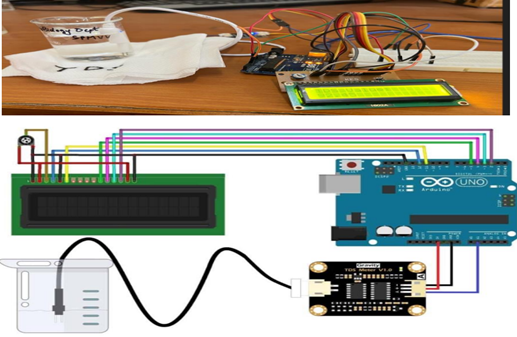
Attach the VCC to the 5V Arduino.
Attach the Arduino GND to the GND.
Attach its analog pin to any Arduino analog pin. the gravity analog TDS sensor with the Arduino and GSM using Analog pin A1
(10) Interfacing the gravity analog TDS sensor with the Arduino and GSM module using Analog pin A1.
- You may measure the quality of the water by connecting a Gravity Analog TDS (Total Dissolved Solids) sensor to an Arduino and a GSM module. The results can then be sent remotely by SMS or other communication techniques.
- Components Required:
- Arduino board (e.g., Arduino Uno or Arduino Mega)
- Gravity Analog TDS Sensor
- GSM module SIM card with SMS capability Breadboard and
- jumper wires
GSM module:
(14) The physical component known as a GSM module makes it possible for electrical devices to communicate with the (15) GSM (Global System for Mobile Communications) network. Cellular communication uses the widely-accepted GSM standard, and GSM modules are frequently employed in a variety of applications for data transmission and reception, voice conversations, and text message (SMS) sending.
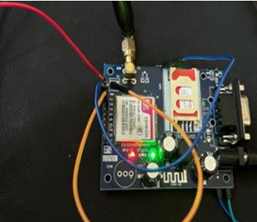
Fig no 7 GSM Module
SMS:
One of the primary uses of GSM modules is to send and receive SMS (Short Message Service) messages. They can be used for various purposes like sending notifications, alerts, or control commands.
Data Communication:
GSM modules provide data connectivity, making it possible to send and receive data over the cellular network. This is essential for IoT (Internet of Things) devices that need to transmit data to remote servers or receive commands from a central server.
(16) SIM Card:
In order to authenticate and establish a connection to the cellular network, GSM modules need a SIM card. The SIM card is necessary for making calls, sending SMS, and using mobile data services. It also stores the subscriber's information.
Interface:
GSM modules typically have serial interfaces (UART or RS232) for communication with microcontrollers or other devices. They can be controlled using AT commands, which are simple text-based commands sent to the module over the serial interface. Please note that as of my last knowledge update in September 2021, 2G networks were gradually being phased out in some regions in favor of newer technologies like 3G, 4G, and 5G. Therefore, it's essential to check the availability of 2G services and the compatibility of GSM modules with your specific application and location. Additionally, technology evolves rapidly, so there may have been developments or changes in the GSM module landscape since my last update.

PH SENSOR
(17) It gauges the water's acidity and basic alkalinity. The hydrogen ion concentration with the negative logarithmic can be used to define it. The pH scale is logarithmic, with a range of 0 to 14. Ph is used to translate the values of hydrogen ion concentrations. In acidic solutions, the hydrogen ion concentration is low; in alkaline solutions, it is high. The natural source water has a PH of about 7. When the number of PH increases tenfold, the concentration of hydrogen ions falls, making the water less acidic. The pH sensor has two electrodes inside: a measuring electrode and a reference electrode. The positive end of the battery, where the reference electrode is located, is where the measuring electrode is linked.
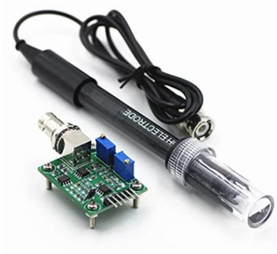
PH SENSOR
Principles of work
(18) The pH of a solution can be measured in a variety of methods. The color changes that occur in chemical powders, such as the litmus strips used in elementary chemistry, are one highly popular method. Today's industrial applications frequently make use of pH probes. Two electrodes on this type of probe provide voltage that is proportionate to the pH of the solution under investigation. To establish an ion selective barrier, one of the two electrodes is a measuring electrode made of special glass. From the vast flock of ions that would otherwise be present in the solution, this barrier hen filters out hydrogen ions. The purpose of the reference electrode's design is to maintain a constant potential at any temperature. When contrasting the potential with the reference potential.
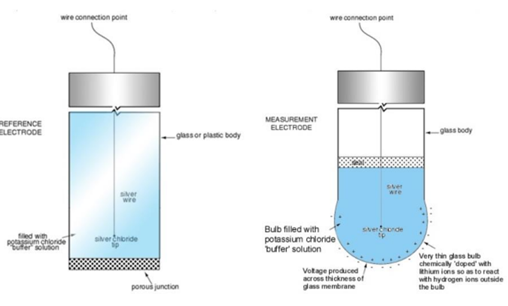
Interfacing pH Sensor with Arduino and LCD display:
Assemble the pH sensor and Arduino:
- Attach the pH sensor's VCC pin to the Arduino's 5V supply.
- -Attach the pH sensor's GND pin to the Arduino's GND pin.
- Attach the pH sensor's OUT pin to an analog input pin on the Arduino, such as A2.
- Assemble the LCD display and Arduino:
- Attach the LCD display's Register Select (RS) pin to the Arduino's second pin.
- -Attach the LCD display's enable pin to the Arduino's third pin.
- Attach the LCD display's D4, D5, D6, and D7 pins to D4, D5, D6, and D7 on the Arduino.
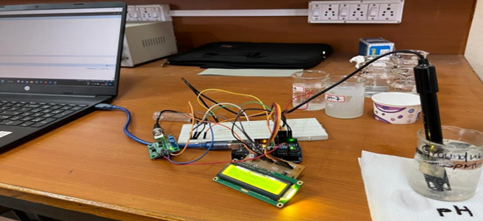
Interfacing pH Sensor with Arduino and LCD display
THINGSPEAK (NODEMCU)
Thing Speak web application:
(19) THE INTERNET OF THINGS:
Items are actuators or sensors. Something that provides information about our surroundings is a sensor. Consider a temperature sensor or maybe your phone's GPS receiver. Actuators are what you want to be able to control, including outlets, lights, pumps, and thermostats. Everything is connected via the "Internet of Things," which also enables us to communicate with our possessions. For instance, your thermostat may adjust itself according to your location.
Thing Speak Elementary:
Thing Speak is an Internet of Things application platform. You can use Thing Speak to create an application based on sensor data.
Thing Speak has the following features:
- data processing,
- real-time data collection,
- visualizations,
- apps, and
- plugins.
With the help of the cloud-based IoT analytics platform service Thing Speak, you can gather, view, and evaluate real-time data streams. (20) Data uploaded by your devices to Thing Speak is instantly visualized by Thing Speak. Thing Speak allows you to run MATLAB code, which allows you to process and analyze data as it comes in online. Thing Speak is frequently used for IoT systems that need analytics for prototyping and proof of concept.
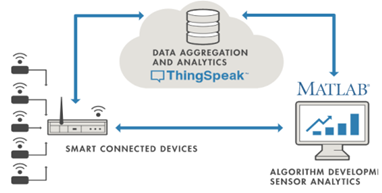
Block diagram of working principle of Thing Speak
KEY FEATURES OF THINGSPEAK:
(21) You can collect, view, and evaluate real-time data streams in the cloud with Thingspeak. Easily setting up devices to submit data to Thing Speak via well-known IoT protocols is one of the platform’s primary features.
- Get real-time sensor data visualization.
- Compile data from outside sources as needed.
- Make sense of your IoT data by utilizing MATLAB’s capabilities.
- Use schedules or events to trigger the automatic execution of your IoT analytics.
- Develop web apps and prototype IoT systems without the need to set up servers.
- Take action on your data automatically and interact with third-party services via Twitter or Twilio.
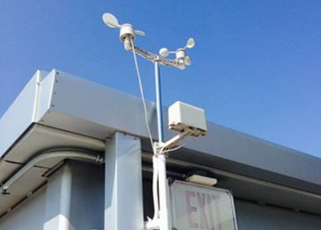
Simple procedure for Think Speak
COLLECT:
(22) Transfer sensor information in secret to the cloud. Sensors are found in many places, including our houses, smartphones, cars, civic infrastructure, and industrial machinery. Sensors are used to measure and detect a wide range of parameters, including pressure, humidity, and temperature. And they convey that information in some way, like an electrical signal or a numerical value.

(23) Things, or sensors, take in information and usually respond locally. With the help of Thing Speak, data from sensors, instruments, and websites may be sent to the cloud and stored on either a public or private channel. By default, Thing Speak keeps data in private channels, but users can share data with others via public channels. You can compute new data, analyze and visualize existing data, and engage with social media, web services, and other devices once the data is in a Thing Speak channel.
ANALYZE:
(23) Use MATLAB to analyze and visualize your data. Having your data stored on the cloud makes it easily accessible. You can examine and display data by using online analytical tools. Data can be used to identify trends, patterns, and relationships. It is possible to compute fresh data. Additionally
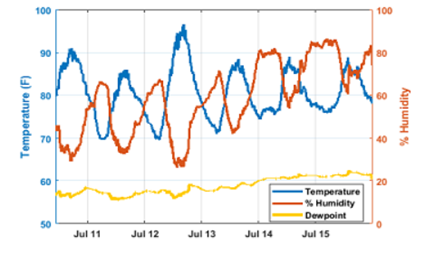
To assist you in understanding data, Thing Speak gives you access to MATLAB.
- You can use the built-in plotting algorithms to visually comprehend relationships in data, as well as schedule calculations to execute at specific periods.
- You can also convert, merge, and generate new data.
- Integrate information from several sources to create a more in-depth study.
- For all of these purposes, as well as others, Things Speak offers solutions that facilitate communication between devices.
You can:
- Respond to data as it enters a channel, including fresh data that you compute and raw data.
- Arrange instructions for a device to carry out.
ACT:
(22) Set off a response Receiving a tweet when the temperature you are monitoring rises above 70° F could be one way to act on data. Alternatively, you may program a more complex operation, like starting a motor when the water level in your water tank falls below a predetermined threshold. Using the Talk Back app, you can even remotely operate gadgets like battery-operated door locks.

-
- For all of these purposes, as well as others, Things Speak offers solutions that facilitate communication between devices. You can:
- Respond to data as it enters a channel, including fresh data that you compute and raw data.
- Arrange instructions for a device to carry out.
(24) MCU NODE An all-in-one microcontroller + WiFi platform, the ESP-12 Lua Node mcu WIFI Dev Board Internet of Things with ESP8266 is incredibly user-friendly for developing projects including Wi-Fi and IoT (Internet of Things) applications. The widely used ESP8266 Wi-Fi Module chip with the ESP-12 SMD footprint serves as the foundation for the board. The ESP8266 (ESP-12E) WiFi development board already has all the parts it needs to write and upload code included in it. You can upload programs and link your circuits right away thanks to its included 3.3V regulator, logic level converter circuit, and USB to serial chip upload codes. This board has an ESP-12E chip with 4MB of flash memory, so you don't have to worry about your lengthy
SPECIFICATIONS:
-
- (25)4MB of flash memory;
- integrated low power 32-bit CPU;
- integrated TCP/IP protocol stack;
- CH340G Serial / USB Chip;
- +19.5dBm output power in 802.11b mode;
- SPI, UART, and SDIO 1.1 / 2.0
- (26) Integrated PLLs, regulators, DCXO, and power management unit;
- integrated TR switch, balun, LNA, power amplifier, and matching network.
- (26) Easily write and upload codes from the Arduino IDE with the onboard USB to serial chip.
- Logic level converter circuits embedded
- Features an integrated 3.3V regulator to guarantee sufficient power for use as your primary WiFi chip!
- Wi-Fi Direct (P2P), 11 b/g/n, soft-AP
- ESP-12E Processor; simple access to the GPIO pins for quick prototyping.
- Simple to use, form factor compatible with breadboards
- 11g module weight;
- good DC to DC conversion;
- voltage regulator/converter.
RESULTS AND DISCUSSION
IoT RESULTS:
- Message Alert Method:
- With this message alert method, for the water samples that are above the limits, the message alerts will be automatically sent to the users.
- If the water samples are within the limits, then the message alerts won’t be sent to the users.
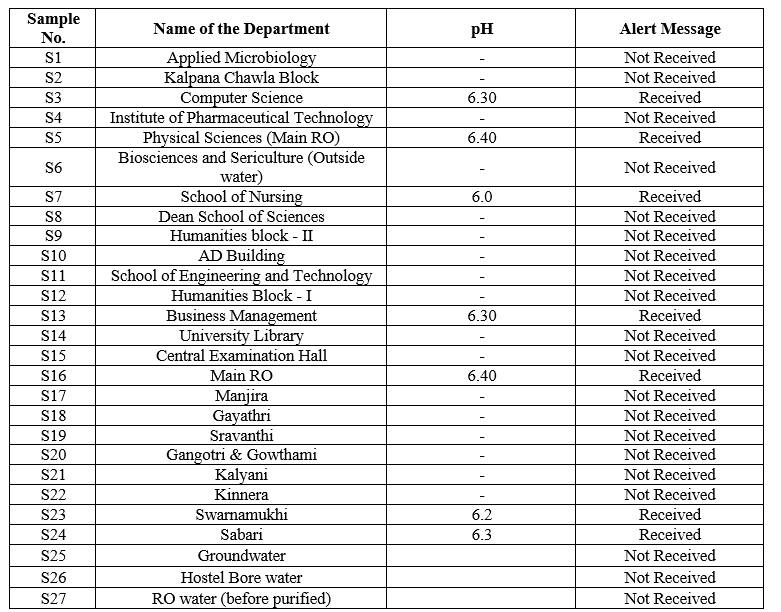
Table No 1. Results of pH by Message Alert Method
From this data, the water samples of S3, S5, S7, S13, S16, S23 and S24 are found to be below the limits.
TOTAL DISSOLVED SOLIDS(TDS):
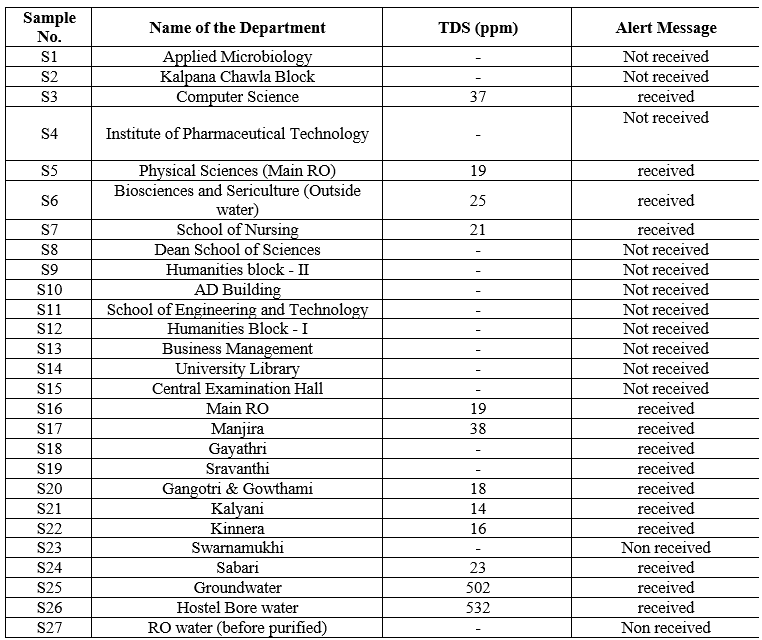
Table No.2 Results of TDS by Message Alert Method
- LCD Display Method:
pH:

Table No.3 Results of pH and TDS by LCD Display Method
CONCLUSION:
The conclusion of water quality monitoring by IoT (Internet of Things) indicates a significant advancement in environmental management and public health. By utilizing a network of sensors and connected devices, this technology enables real-time data collection and analysis of various water quality parameters such as pH, temperature, turbidity, and contamination levels. This allows for immediate detection of pollutants and anomalies, facilitating prompt responses to potential hazards. IoT-based water quality monitoring systems offer a cost-effective, efficient, and scalable solution to ensure the safety and cleanliness of water resources. Furthermore, they empower communities and stakeholders with actionable insights, promoting sustainable water management practices and supporting the preservation of this vital resource for future generations
REFERENCES
- Hemanth DJ, Kumar VA, Malathi S, Castillo O, Patrut B, editors. Emerging Trends in Computing and Expert Technology
- Jabbar WA, Ting TM, Hamidun MF, Kamarudin AH, Wu W, Sultan J, Alsewari AA, Ali MA. Development of LoRaWAN-based IoT system for water quality monitoring in rural areas. Expert Systems With Applications. 2024 May 15;242:122862.
- Lakshmikantha V, Hiriyannagowda A, Manjunath A, Patted A, Basavaiah J, Anthony AA. IoT based smart water quality monitoring system. Global Transitions Proceedings. 2021 Nov 1;2(2):181-6.
- Cebrián Cuenca MA, Mira JJ, Caride Miana E, Fernández Jiménez A, Orozco Beltrán D. Psychological distress and associated factors related to COVID-19 pandemic among primary care physicians in Spain (STREPRIC study). Research Square.[consultado 4 Jun 2020] Disponible en: https://assets. researchsquare. com/files/rs-27476/v1/611ed983-a41b-4894-b04e-672d2bc85a08. pdf. 2020.
- Memon AR, Memon SK, Memon AA, Memon TD. IoT based water quality monitoring system for safe drinking water in Pakistan. In2020 3rd International Conference on Computing, Mathematics and Engineering Technologies (iCoMET) 2020 Jan 29 (pp. 1-7). IEEE.
- Zhou H, Hu X, Xiang X, McClements DJ. Modification of textural attributes of potato protein gels using salts, polysaccharides, and transglutaminase: Development of plant-based foods. Food Hydrocolloids. 2023 Nov 1;144:108909.
- Rajeshwari M. BIPOLAR FUZZY GRAPH DETECTS VIRUS SPREAD BETWEEN INWARD AND OUTWARD LINKS OF A WEB PAGE. Journal of Pharmaceutical Negative Results. 2022 Dec 31:6603-10.
- Sarumpaet S. Similarity Check: Factors Affecting Whistleblowing Intention: Case Study on the Implementation of Village Funds.
- Kibwana Z. Effectiveness of the Completion of Historical Site Renovation Projects in Zanzibar (Doctoral dissertation, Institute of Accountancy Arusha (IAA)).
- Andraini L, Surahman A. Design And Implementation Of 02244 TDS Meter Gravity Sensor And 4502C pH Sensor On Hydroponic. In2022 International Conference on Information Technology Research and Innovation (ICITRI) 2022 Nov 10 (pp. 129-134). IEEE.
- Ramdane K. An Arduino-based Water Quality Monitoring System using pH, Temperature, Turbidity, and TDS Sensors.
- Araneta AA. Design of an Arduino-Based Water Quality Monitoring System. International Journal of Computer Science and Mobile Computing. 2022;11(3):152-65.
- Kim SB, Kim WK, Chounlamany V, Seo J, Yoo J, Jo HJ, Jung J. Identification of multi-level toxicity of liquid crystal display wastewater toward Daphnia magna and Moina macrocopa. Journal of hazardous materials. 2012 Aug 15;227:327-33.
- Pradeep S, Neha P, Chandrika T, Rani NS, Gowthami P. Smart Access Control System and Ultimate SecuritySolution for Vehicle Parking. In2023 IEEE 5th International Conference on Cybernetics, Cognition and Machine Learning Applications (ICCCMLA) 2023 Oct 7 (pp. 76-82). IEEE.
- Gokulanathan S, Manivasagam P, Prabu N, Venkatesh T. A GSM based water quality monitoring system using Arduino. Shanlax International Journal of Arts, Science and Humanities. 2019 Apr;6(4):22-6.
- Siregar IM, Siagian NF, Siregar VM. A Design of an Electric Light Control Device Using Arduino Uno Microcontroller-Based Short Message Service. Internet of Things and Artificial Intelligence Journal. 2022 May 18;2(2):98-110.
- Sahu N, Bhardwaj R, Shah H, Mukhiya R, Sharma R, Sinha S. Towards development of an ISFET-based smart pH sensor: Enabling machine learning for drift compensation in IoT applications. IEEE Sensors Journal. 2021 Jun 7;21(17):19013-24.
- Singh S, Kumar A, Prasad A, Bharadwaj N. IoT based water quality monitoring system. IRFIC. 2016.
- Pasha S. ThingSpeak based sensing and monitoring system for IoT with Matlab Analysis. International Journal of New Technology and Research (IJNTR). 2016 Jun;2(6):19-23.
- Memon AR, Memon SK, Memon AA, Memon TD. IoT based water quality monitoring system for safe drinking water in Pakistan. In2020 3rd International Conference on Computing, Mathematics and Engineering Technologies (iCoMET) 2020 Jan 29 (pp. 1-7). IEEE.
- Penchalaiah N, Nelson Emmanuel J, Suraj Kamal S, Lakshmi Narayana CV. IoT based smart farming using thingspeak and MATLAB. InICCCE 2020: Proceedings of the 3rd International Conference on Communications and Cyber Physical Engineering 2020 Oct 12 (pp. 1273-1295). Singapore: Springer Nature Singapore. .
- Nagaraja GS, Soppimath AB, Soumya T, Abhinith A. IoT based smart agriculture management system. In2019 4th International Conference on Computational Systems and Information Technology for Sustainable Solution (CSITSS) 2019 Dec 20 (pp. 1-5). IEEE.
- Pasha S. ThingSpeak based sensing and monitoring system for IoT with Matlab Analysis. International Journal of New Technology and Research (IJNTR). 2016 Jun;2(6):19-23.
- Schwartz M. Internet of Things with ESP8266. Packt Publishing Ltd; 2016 Jul 29.
- Rodríguez BG, Meneses JS, Garcia-Rodriguez J. Implementation of a low-cost rain gauge with Arduino and Thingspeak. In15th International Conference on Soft Computing Models in Industrial and Environmental Applications (SOCO 2020) 15 2021 (pp. 770-779). Springer International Publishing. .
- Pramudianto F. Rapid application development in the internet of things: a model-based approach (Doctoral dissertation, Dissertation, RWTH Aachen University, 2015).


 K. Swathi*
K. Swathi*
 U. Madhavi
U. Madhavi
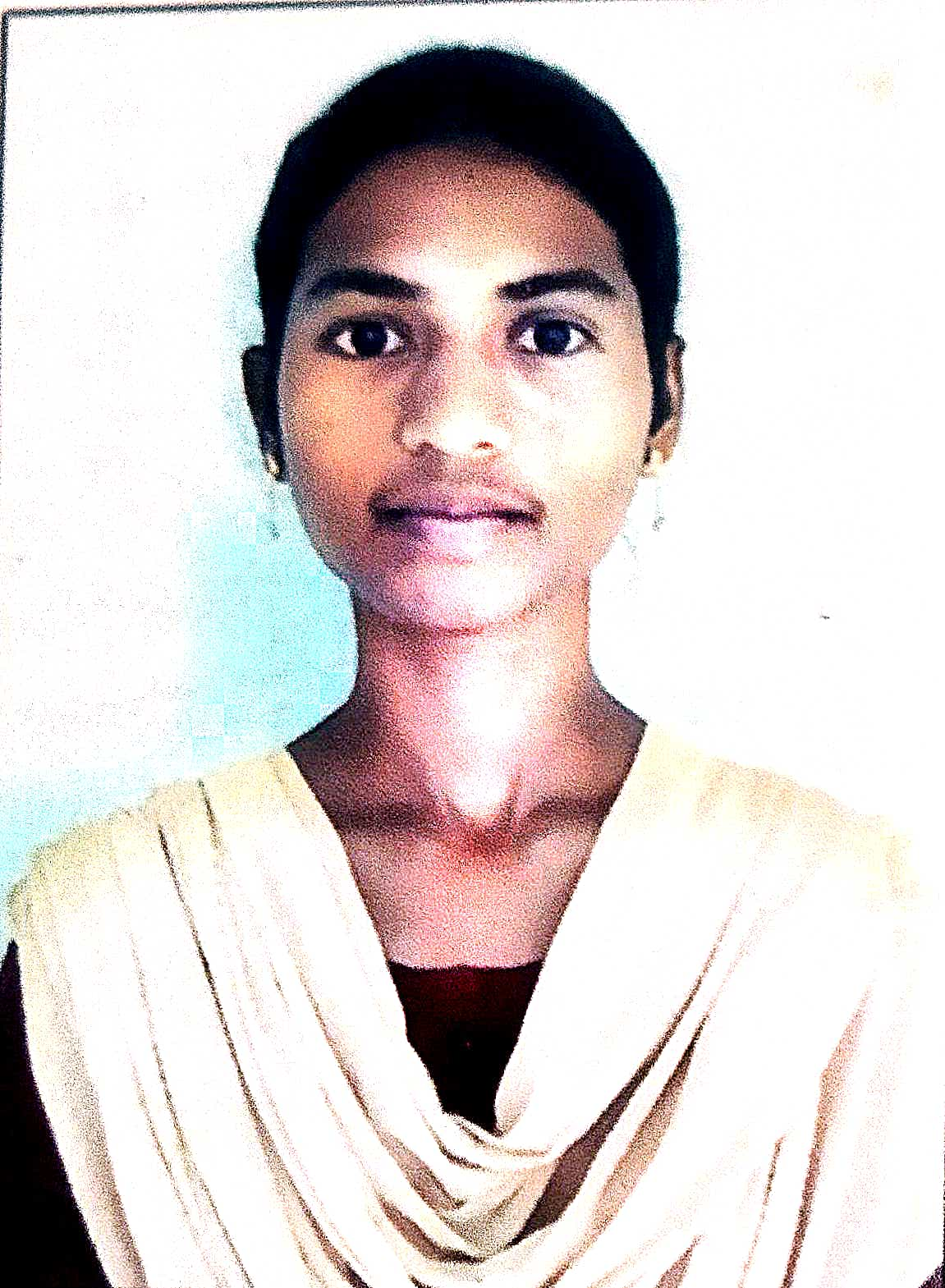 D. Kalyani
D. Kalyani
 P. Sai Pratyusha
P. Sai Pratyusha


















 10.5281/zenodo.10913301
10.5281/zenodo.10913301